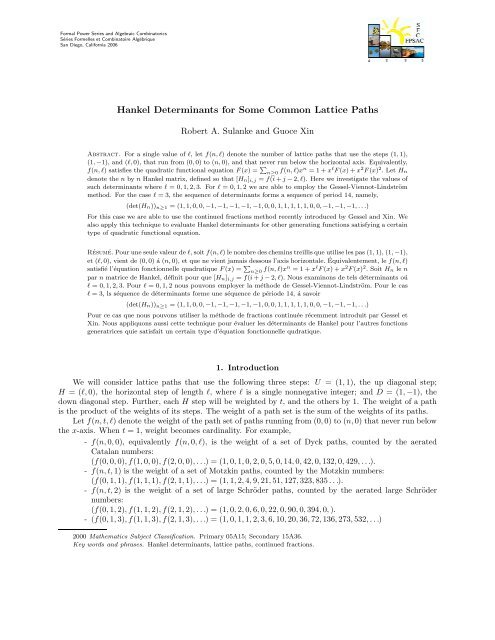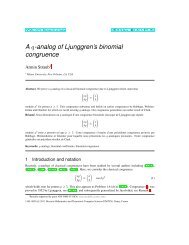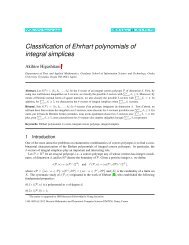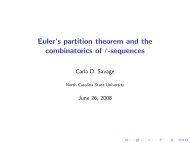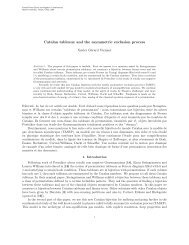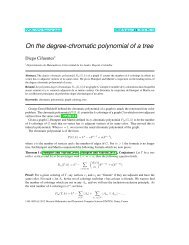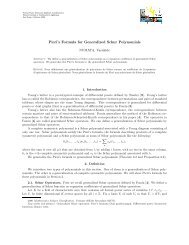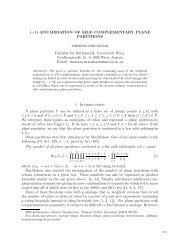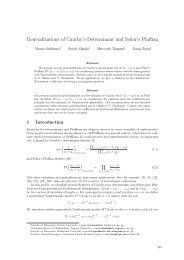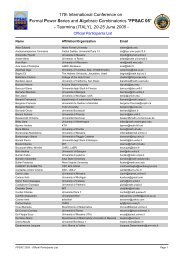Hankel Determinants for Some Common Lattice Paths - garsia at york
Hankel Determinants for Some Common Lattice Paths - garsia at york
Hankel Determinants for Some Common Lattice Paths - garsia at york
You also want an ePaper? Increase the reach of your titles
YUMPU automatically turns print PDFs into web optimized ePapers that Google loves.
HANKEL DETERMINANTS FOR LATTICE PATHSSince, by the i-t-config of Lemma 2.2, (H) i,j = |P i,j | counts the large Schröder p<strong>at</strong>hs from (0, 0) to(2i+2j −2, 0), immedi<strong>at</strong>ely we have the the following corollary <strong>for</strong> the <strong>Hankel</strong> determinants of the weightednon-aer<strong>at</strong>ed Schröder numbers:Proposition 2.1. Let f n denote the weight of the p<strong>at</strong>h set of p<strong>at</strong>hs from (0, 0) to (2n, 0) which neverrun bene<strong>at</strong>h the x-axis and where H = (2, 0) is weighted by t. Equivalently, let f n s<strong>at</strong>isfyF(x) = ∑ n≥0f n x n = 1 + txF(x) + xF(x) 2 .Then the determinant of the n-th order <strong>Hankel</strong> m<strong>at</strong>rix equals (1 + t) n(n−1)/2 .As a second corollary to Lemma 2.2, we haveLemma 2.3. For the l<strong>at</strong>tice p<strong>at</strong>hs th<strong>at</strong> use the steps U, H = (2, 0), and D, th<strong>at</strong> never run below thex-axis, and th<strong>at</strong> have the i-t-config with(x i , y i ) = (−2i + 1, 0) and (x ′ i, y ′ i) = (2i − 1, 0)<strong>for</strong> 1 ≤ i ≤ n, the sum of the signed weights <strong>for</strong> the nonintersecting n-tuples in ∪ σ∈Sn P σ is (1 + t) n(n+1)/2 .Proof of Lemma 2.3. We first transl<strong>at</strong>e all p<strong>at</strong>hs upwards one unit and then prepend a U-step andappend a D-step to every p<strong>at</strong>h. Next we add the point p<strong>at</strong>h <strong>at</strong> (0, 0). The sum of the signed weights of thenonintersecting n-tuples in the original configur<strong>at</strong>ion equals th<strong>at</strong> of the nonintersecting n + 1-tuples in thisnew configur<strong>at</strong>ion, which in turn is given by Lemma 2.2.□Proof of Proposition 1.2. Suppose th<strong>at</strong> n is even; the proof when n is odd is similar. Here the<strong>Hankel</strong> m<strong>at</strong>rix (|P i,j |) 1≤i,j≤n corresponds to the i-t-config with(x i , y i ) = (−i + 1, 0) and (x ′ i, y ′ i) = (i − 1, 0) <strong>for</strong> 1 ≤ i ≤ n.Since l = 2, no endpoint of a step on a p<strong>at</strong>h th<strong>at</strong> origin<strong>at</strong>es from an oddly indexed initial point (i.e., a point(−i + 1, 0) <strong>for</strong> odd i) will intersect an endpoint of a step on a p<strong>at</strong>h th<strong>at</strong> origin<strong>at</strong>es from an evenly indexedinitial point. Moreover, <strong>for</strong> any permut<strong>at</strong>ion σ corresponding to a nonintersecting n-tuple, σ(i) − i must beeven <strong>for</strong> each i, and hence sgn(σ) = 1. Thus the weight of the nonintersecting n-tuples is the product ofthe weight of those origin<strong>at</strong>ing from oddly indexed initial points times the weight of those origin<strong>at</strong>ing fromevenly indexed initial points.Hence, with m = n/2, let i-t-configA haveand let i-t-configB have(x i , y i ) = (−2i + 2, 0) and (x ′ i, y ′ i) = (2i − 2, 0) <strong>for</strong> 1 ≤ i ≤ m,(x i , y i ) = (−2i + 1, 0) and (x ′ i, y ′ i) = (2i − 1, 0) <strong>for</strong> 1 ≤ i ≤ m.Applying Lemmas 2.2 and 2.3 to these configur<strong>at</strong>ions yields the weight of nonintersecting n-tuples of theoriginal configur<strong>at</strong>ion as(1 + t) m(m−1)/2 (1 + t) m(m+1)/2 = (1 + t) m2 = (1 + t) n2 /4 .□Next we consider <strong>Hankel</strong> determinants <strong>for</strong> sequences of p<strong>at</strong>h weights th<strong>at</strong> ignore the initial term. Forthe sequence f(1, t, l), f(2, t, l), . . ., we will let H 1 n denote the m<strong>at</strong>rix where the entries s<strong>at</strong>isfy (H1 n ) i,j =f(i + j − 1, t, l). See Figure 2.Proposition 2.2. For l = 1 (Motzkin case again), the sequence of determinants s<strong>at</strong>isfies the recurrencesubject to det(H1 1) = t and det(H1 2 ) = (t − 1)(t + 1).det(H 1 n ) = t det(H1 n−1 ) − det(H1 n−2 )
Sulanke and Xin(0,0) (3,0)Figure 2. Three of the 4-tuples of p<strong>at</strong>hs <strong>for</strong> l = 1 and <strong>for</strong> i-t-config with[(0, 0), (−1, 0), (−2, 0), (−3, 0)] and [(1, 0), (2, 0), (3, 0), (4, 0)]. The first and second 4-tuplesare both nonintersecting. The first has a signed weight of t 4 while the second has a signedweight of −t 2 . The third is intersecting only <strong>at</strong> the point (0, 1).Proof. Aigner [1] considered the case <strong>for</strong> t = 1. For arbitrary t, our proof considers how the particularp<strong>at</strong>hs must look in the nonintersecting case. Observe th<strong>at</strong> det(Hn 1 ) is the sum of the weights of thenonintersecting n-tuples <strong>for</strong> the i-t-config(n) taken as[(0, 0), (−1, 0), . . ., (n − 1, 0)] and [(1, 0), (2, 0), . . ., (n, 0)].Each of these nonintersecting n-tuples belongs to one of two types: (1) those containing the p<strong>at</strong>h from (0, 0)to (1, 0) with all other p<strong>at</strong>hs <strong>for</strong>ced to begin with U, end with D, and have ordin<strong>at</strong>e <strong>at</strong> least one elsewhere;(2) those containing the p<strong>at</strong>h UD from (0, 0) to (2, 0) and the p<strong>at</strong>h UD (−1, 0) to (1, 0) with all other p<strong>at</strong>hs<strong>for</strong>ced to begin with UU, end with DD, and have ordin<strong>at</strong>e <strong>at</strong> least two elsewhere. The set of the first typehas a total weight t times the sum of the weights of the nonintersecting (n−1)-tuples on the i-t-config(n-1),which is t det(Hn−1). 1 Since each n-tuple of the second type has the defined crossing of the p<strong>at</strong>h from (0, 0)with th<strong>at</strong> from (−1, 0), the set has total weight is the sign of the corresponding permut<strong>at</strong>ion times the sumof the weights of the nonintersecting (n − 2)-tuples on the i-t-config(n-2), which is − det(Hn−2).1 □For l = 2, we will indic<strong>at</strong>e how Lemma 2.3 provesProposition 2.3. For n ≥ 0, l = 2, and arbitrary t, the sequence of determinants s<strong>at</strong>isfies{ 0det(Hn 1 ) = (−1) n/2 (1 + t) n(n+2)/4if n is oddif n is evenProof. Here the <strong>Hankel</strong> m<strong>at</strong>rix can correspond to i-t-config with(x i , y i ) = (−i + 1, 0) and (x ′ i , y′ i ) = (i, 0) <strong>for</strong> 1 ≤ i ≤ n.Since l = 2, if there is a p<strong>at</strong>h from (x i , y i ) to (x ′ j , y′ j ), then i − j is odd. It follows th<strong>at</strong>, if n is odd, therecan be no n-tuples of p<strong>at</strong>hs <strong>for</strong> the configur<strong>at</strong>ion. If n is even and m = n/2, the sign of any permut<strong>at</strong>ion<strong>for</strong> an nonintersecting n-tuples can be shown to be (−1) m . Thus the weight of the nonintersecting n-tuplesis (−1) m times the weight of those origin<strong>at</strong>ing from oddly indexed initial points times the weight of thoseorigin<strong>at</strong>ing from evenly indexed initial points. The proof is completed by applying 2.3 to i-t-configA withand to i-t-configB with(x i , y i ) = (−2i + 2, 0) and (x ′ i , y′ i ) = (2i, 0) <strong>for</strong> 1 ≤ i ≤ m,(x i , y i ) = (−2i + 1, 0) and (x ′ i, y ′ i) = (2i − 1, 0) <strong>for</strong> 1 ≤ i ≤ m.3. Periodicity fourteen and continued fractionsHere we will repe<strong>at</strong>ed apply the “continued fractions method” recently developed by Gessel and Xin [6] todetermine the periodicity of the sequence of <strong>Hankel</strong> determinants <strong>for</strong> l = 3 and t = 1. This method, presentedmore <strong>for</strong>mally in the next section, trans<strong>for</strong>ms both gener<strong>at</strong>ing functions and corresponding determinants. Inthis section we will concentr<strong>at</strong>e on the specific gener<strong>at</strong>ing function F(x) s<strong>at</strong>isfyingF(x) = 1 + x 3 F(x) + x 2 F(x) 2 .From this functional equ<strong>at</strong>ion, or from the rel<strong>at</strong>ed recurrence <strong>for</strong> its coefficients, there appears to be no cluewhy the associ<strong>at</strong>ed sequence of <strong>Hankel</strong> determinants should have a period of 14.□
HANKEL DETERMINANTS FOR LATTICE PATHSFor an arbitrary gener<strong>at</strong>ing function D(x, y) = ∑ ∞i,j=0 d i,jx i y j , let [D(x, y)] n denote the n by n determinantdet((d i,j ) 0≤i,j≤n−1 ). For any A(x) = ∑ n≥0 a nx n , define the <strong>Hankel</strong> m<strong>at</strong>rix <strong>for</strong> A of order n, n ≥ 1,by H n (A) = (a i+j−2 ) 1≤i,j≤n . It is straight <strong>for</strong>ward to show th<strong>at</strong> the <strong>Hankel</strong> determinant det(H n (A)) can beexpressed as][ xA(x) − yA(y)det(H n (A)) =x − yWe will use an easily-proven “product rule” of [6] <strong>for</strong> trans<strong>for</strong>ming the gener<strong>at</strong>ing functions: If u(x) isa <strong>for</strong>mal power series with u(0) = 1, then.n[u(x)D(x, y)] n = [D(x, y)] n = [u(y)D(x, y)] n .We will make five trans<strong>for</strong>m<strong>at</strong>ions showing, <strong>for</strong> n ≥ 8,⎛ ⎛ ⎡det(H n (F)) = det⎝diag⎝[1], [1],⎣ 0 0 10 1 01 0 −2⎤⎞⎞⎦,[1], [1], H n−7 (F) ⎠⎠ ,where the right side is the determinant of a block-diagonal m<strong>at</strong>rix consisting of six blocks along the diagonal,four of which are 1 by 1 identity m<strong>at</strong>rices, and having entry 0 elsewhere. It then follows th<strong>at</strong> det(H n (F)) =− det(H n−7 (F)). This implies th<strong>at</strong> the period <strong>for</strong> det(H n (F)) is 14, and Proposition 1.3 will be proved.We start with F 0 (x) = F(x), and define F i (x) from F i−1 (x) according to a trans<strong>for</strong>m<strong>at</strong>ion where each<strong>Hankel</strong> determinant <strong>for</strong> F i (x) are derived from one <strong>for</strong> F i−1 (x) with the aid of the product rule, which is notalways mentioned. In the following, F i (x) will always s<strong>at</strong>isfy a quadr<strong>at</strong>ic functional equ<strong>at</strong>ionwhich is equivalent to the continued fractiona(x)F i (x) 2 + b(x)F i (x) + c(x) = 0,F i (x) =−c(x)b(x) + a(x)F i (x) .In particular, <strong>for</strong> l = 3,1F 0 (x) =1 − x 3 − x 2 F 0 (x) .Trans<strong>for</strong>m<strong>at</strong>ion 1: Using this continued fraction of F 0 , substitution, and simplific<strong>at</strong>ion we obtain[ ] [xF0 (x) − yF 0 (y) −xy 2 F 0 (y) + yx 2 F 0 (x) + (x − y) ( yx 2 + xy 2 + 1 ) ]det(H n (F)) ==x − y(1 − x 3 − x 2 F 0 (x))(1 − y 3 − y 2 .F 0 (y))(x − y)nMultiplying by (1 − x 3 − x 2 F 0 (x))(1 − y 3 − y 2 F 0 (y)), which will not affect the value of the determinant bythe product rule, we can write the determinant as[1 + xy xF ]1(x) − yF 1 (y)x − ynwhere(3.1) F 1 (x) = F 0 (x) + x.The associ<strong>at</strong>ed m<strong>at</strong>rix is block-diagonal with two blocks: the m<strong>at</strong>rix [1] and the <strong>Hankel</strong> m<strong>at</strong>rix <strong>for</strong> F 1 (x).Certainly,det(H n (F 0 )) = det(H n−1 (F 1 )).From (3.1) and the functional equ<strong>at</strong>ion <strong>for</strong> F 0 (x), we obtain the functional equ<strong>at</strong>ionF 1 (x) =1 + x1 + x 3 − x 2 F 1 (x) .Trans<strong>for</strong>m<strong>at</strong>ion 2: Using this continued fraction <strong>for</strong> F 1 , substituting in xF 1(x) − yF 1 (y), and multiplyingby (1 + x 3 − x 2 F 1 (x))(1 + y 3 − y 2 F 1 (y)) yieldsx − y[ ] [ xF1 (x) − yF 1 (y) −xy 2 (x + 1)F 1 (y) + yx 2 ](y + 1)F 1 (x) − (y + 1)(x + 1)(xy − 1)(x − y)=x − yx − ynn.n
Sulanke and XinUpon multiplying by (1 + x) −1 (1 + y) −1 , the determinant is equal to[1 + xy xF ]2(x) − yF 2 (y)x − ywhere(3.2) F 2 (x) = F 1 (x)/(1 + x) − 1.The associ<strong>at</strong>ed m<strong>at</strong>rix being block diagonal shows,ndet(H n−1 (F 1 )) = det(H n−2 (F 2 )).From (3.2) and the functional equ<strong>at</strong>ion <strong>for</strong> F 1 (x), we obtainF 2 (x) =x 21 − 2x 2 − x 3 − (x 3 + x 2 )F 2 (x) .Trans<strong>for</strong>m<strong>at</strong>ion 3: Substituting <strong>for</strong> F 2 with the above fraction, simplifying, [ and multiplying]by (1 +x)(1 −x−x 2 −x 2 F 2 (x))(1+y)(1 −y −y 2 −y 2 xF2 (x) − yF 2 (y)F 2 (y)) shows th<strong>at</strong> the determinantequalsx − yn[y 2 x 3 (y + 1)F 2 (y) − x 2 y 3 (x + 1)F 2 (x) − (x − y) ( 2 y 2 x 2 − x 2 − xy − y 2) ]x − ywhich can be rewritten as[x 2 + xy + y 2 − 2x 2 y 2 + x 3 y 3 xF ]3(x) − yF 3 (y),x − ynwhere F 3 (x) is indeed a power series s<strong>at</strong>isfying(3.3) F 3 (x) = (x + 1)F 2 (x)/x 2 .This time the corresponding m<strong>at</strong>rix is a block-diagonal m<strong>at</strong>rix with the blockthe <strong>Hankel</strong> m<strong>at</strong>rix <strong>for</strong> F 3 (x). Hencedet(H n−2 (F 2 )) = − det(H n−5 (F 3 )).From (3.3) and the functional equ<strong>at</strong>ion <strong>for</strong> F 2 (x), we obtainF 3 (x) =1 + x1 − 2x 2 − x 3 − x 4 F 3 (x) .⎡n⎣ 0 0 10 1 01 0 −2⎤⎦ followed byTrans<strong>for</strong>m<strong>at</strong>ion 4: Substituting <strong>for</strong> F 3 with the fraction, [ simplifying, ] and multiplying by (1 − 2x 2 −x 3 − x 4 F 3 (x))((1 − 2y 2 − y 3 − y 4 xF3 (x) − yF 3 (y)F 3 (y)) the determinantequalsx − yn[ −xy 4 (x + 1)F 3 (y) + yx 4 ](y + 1)F 3 (x) + (y + 1)(x + 1)(xy + 1)(x − y)x − yBy multiplying the gener<strong>at</strong>ing function by (1 + x) −1 (1 + y) −1 , this determinant becomes[1 + xy xF ]4(x) − yF 4 (y)x − ywhere(3.4) F 4 (x) = 1 + x 2 F 3 (x)/(1 + x).There<strong>for</strong>e,,ndet(H n−5 (F 3 )) = det(H n−6 (F 4 )).From (3.4) and the functional equ<strong>at</strong>ion <strong>for</strong> F 3 (x), we obtainF 4 (x) =11 + x 3 − (x 3 + x 2 )F 4 (x) ..n
HANKEL DETERMINANTS FOR LATTICE PATHSTrans<strong>for</strong>m<strong>at</strong>ion 5: Substituting <strong>for</strong> [ F 4 with the above ] fraction, simplifying, and multiplying by (1 −x 2 F 4 (x))(1 − y 2 xF4 (x) − yF 4 (y)F 4 (y)) the determinantequalsx − yn[−xy 2 (y + 1)F 4 (y) + x 2 y (x + 1)F 4 (x) − (x − y) ( yx 2 + xy 2 − 1 ) ] [= 1 + xy xF ]5(x) − yF 5 (y),x − yx − ynwhere F 5 (x) = (1 + x)F 4 (x) − x. Hence, det(H n−6 (F 4 )) = det(H n−7 (F 5 )).Finally, it is routinely checked th<strong>at</strong> F 5 (x) = F 0 (x).4. The quadr<strong>at</strong>ic trans<strong>for</strong>m<strong>at</strong>ion <strong>for</strong> <strong>Hankel</strong> determinantsOne can use the method introduced in the previous section to evalu<strong>at</strong>e the <strong>Hankel</strong> determinants <strong>for</strong>gener<strong>at</strong>ing functions s<strong>at</strong>isfying a certain type of quadr<strong>at</strong>ic functional equ<strong>at</strong>ion. The gener<strong>at</strong>ing functionsF(x) in this section are the unique solution of a quadr<strong>at</strong>ic functional equ<strong>at</strong>ion s<strong>at</strong>isfying(4.1) F(x) =x du(x) + x k v(x)F(x) ,where u(x) and v(x) are r<strong>at</strong>ional power series with nonzero constants, d is a nonneg<strong>at</strong>ive integer, and k is apositive integer. Note th<strong>at</strong> if k = 0, F(x) is not unique. Our task now is to derive a trans<strong>for</strong>m<strong>at</strong>ion T soth<strong>at</strong> det(H n (F)) = a det(H n−d−1 (T (F))) <strong>for</strong> some value a and nonneg<strong>at</strong>ive integer d. In addition to <strong>Hankel</strong>m<strong>at</strong>rices <strong>for</strong> the power series A = ∑ n≥0 a ix i , we will consider shifted <strong>Hankel</strong> m<strong>at</strong>rices: H k n(A) denotes them<strong>at</strong>rix (a i+j+k−2 ) 1≤i,j≤n . Shifted m<strong>at</strong>rices have appeared in Proposition 2.2 and 2.3.The first proposition is elementary:Proposition 4.1. If F s<strong>at</strong>isfies (4.1), then G = u(0)F s<strong>at</strong>isfiesdet(H n (G)) = u(0) n det(H n (F)), and G(x) =nx du(0) −1 u(x) + x k u(0) −2 v(x)G(x) .Proposition 4.2. Suppose F s<strong>at</strong>isfies (4.1) with u(0) = 1. We separ<strong>at</strong>e u(x) uniquely as u(x) =u L (x) + x d+2 u H (x), where u L (x) is a polynomial of degree <strong>at</strong> most d + 1 and u H (x) is a power series.(i) If k = 1, then there is a unique G such th<strong>at</strong>Moreover,G(x) =and a shifted m<strong>at</strong>rices appears with−v(x) − xu L (x)u H (x)u L (x) − x d+2 u H (x) − x d+1 G(x) ,G(x) = −xu H (x) − x −d v(x)F(x)det(H 1 n−d−1 (G(x))) = (−1)d(d+1)/2 det(H n (F(x))).(ii) If k ≥ 2, then there is a unique G such th<strong>at</strong>Moreover,andG(x) =−x k−2 v(x) − u L (x)u H (x)u L (x) − x d+2 u H (x) − x d+2 G(x) ,G(x) = −u H (x) − x k−d−2 v(x)F(x)det(H n−d−1 (G(x))) = (−1) d(d+1)/2 det(H n (F(x))).Proof. We prove only part (ii) as part (i) is similar. The gener<strong>at</strong>ing function <strong>for</strong> H n (F) is given byxF(x) − yF(y)= 1 (x d+1x − y x − y u(x) + x k v(x)F(x) − y d+1 )u(y) + y k v(y)F(y)= −yd+1 u(x) − y d+1 x k v(x)F(x) + x d+1 u(y) + x d+1 y k v(y)F(y)(u(x) + x k v(x)F(x)) (u(y) + y k v(y)F(y))(x − y)
Sulanke and XinWe can multiply by (u(x)+x k v(x)F(x)) and by (u(y)+y k v(y)F(y)) without changing the above determinantby the product rule. Next we observe th<strong>at</strong> x d divides F(x), and write u(x) = u L (x) + x d+2 u H (x) as in theproposition. The resulting gener<strong>at</strong>ing function can be written as−y d+1 u L (x) + x d+1 u L (y)x − y+ (xy) d+1 −x(u H(x) − x k−d−2 v(x)F(x)) + y(u H (y) + y k−d−2 v(y)F(y)).x − yWe now set G(x) = −u H (x) − x k−d−2 v(x)F(x), which can be straight<strong>for</strong>wardly[ shown to agree ] withxF(x) − yF(y)the defining functional equ<strong>at</strong>ions. Suppose th<strong>at</strong> u L (x) = 1 + a 1 x + · · · a d+1 x d+1 , thenisx − ynequal to the determinant of the block-diagonal m<strong>at</strong>rix⎛⎛⎞ ⎞0 · · · 0 1diag....⎜⎜⎟⎝⎝0 1 . a d−1⎠ , H(G(x)) ⎟⎠ .1 a 1 · · · a dThe determinant of the first block is easily seen to be (−1) d(d+1)/2 .□Given these propositions and th<strong>at</strong> H 1 (A) = H(x −1 (A(x) − A(0))) <strong>for</strong> any series A, we can now defineour trans<strong>for</strong>m<strong>at</strong>ion T (F): For F s<strong>at</strong>isfying (4.1),• if u(0) ≠ 1, then T (F) = G, as given in Proposition 4.1.• if u(0) = 1 and k = 1, then T (F) = x −1 (G(x) − G(0)), with G given in Proposition 4.2(i).• if u(0) = 1 and k ≥ 2, then T (F) = G, as given in Proposition 4.2(ii).Moreover, the rel<strong>at</strong>ion between det(H n (F)) and det(H n (T (F))) is given in Propositions 4.1 and 4.2.Example 1: Other proofs of Propositions 1.1 and 2.2. For Motzkin p<strong>at</strong>hs with arbitrary t, thegener<strong>at</strong>ing function F(x) s<strong>at</strong>isfies1F(x) =1 − tx − x 2 F(x) .Applying Proposition 4.2 so F 1 = T (F) givesdet(H n−1 (F 1 )) = det(H n (F)) where F 1 (x) =11 − tx − x 2 F 1 (x) .Hence, F(x) = F 1 (x), and consequently det(H n (F(x))) = 1 <strong>for</strong> all n.Whereas the Gessel-Viennot-Lindström method leads to a proof in the shifted case <strong>for</strong> arbitrary t, as inProposition 2.2, we have been able to use the continued fractions technique only <strong>for</strong> t = 1 and t = 2.For t = 1 we will show th<strong>at</strong> (det(Hn 1(F))) n≥1 = (1, 0, −1, −1, 0, 1, 1, . . .), continuing with period 6. LetG 1 (x) = (F(x) − 1)/x, so th<strong>at</strong> det(Hn(F)) 1 = det(H n (G 1 )). Let G 2 = T (G 1 ) and G 3 = T (G 2 ), both underProposition 4.2(ii). Since1 + xG 1 (x) =1 − x − 2x 2 − x 3 G 1 (x)with d = 0, k = 3, u(x) = u L (x) = 1 − 2x, u H = 0, and v(x) = −(1 + x) −1 , we find th<strong>at</strong>xG 2 (x) =1 − x − 2x 2 − x 2 (1 + x)G 2 (x)with d = 1, k = 2, u(x) = u L (x) = 1 − x − 2x 2 , u H = 0, and v(x) = −(1 + x). Applying Proposition 4.2(ii)showsG 3 (x) = −x −1 (−(1 + x))G 2 (x)= −x −1 (−(1 + x))(−x(−(1 + x) −1 ))G 1 (x)= G 1 (x)and det(H n−3 (G 3 )) = − det(H n−1 (G 2 )) = − det(H n (G 1 )), which yields the periodicity of the sequence ofdeterminants.
HANKEL DETERMINANTS FOR LATTICE PATHSFor t = 2 we will show th<strong>at</strong> det(H 1 n(F)) = n + 1 <strong>for</strong> n ≥ 1. Define, G 1 to s<strong>at</strong>isfy,G 1 (x) =2 + x1 − 2x − 2x 2 − x 3 G 1 (x) .One can easily see th<strong>at</strong> G 1 (x) = (F(x) − 1)/x with G 1 (0) = u 1 (0) −1 = det(H 1 (G 1 )) = det(H 1 1(F)) = 2. Forn ≥ 2, define, G n to s<strong>at</strong>isfy,G n (x) =(n − 1) 2 (n 2 + n + x)(n 2 − n)(n 2 − 2n 2 x − 2x 2 ) − n 2 (n 2 − n + x)x 2 G n (x) .By induction one can show th<strong>at</strong> G n = T ◦ T (G n−1 ) (under Prop. 4.1 then under Prop. 4.2), and th<strong>at</strong>G n (0) = u n (0) −1 = (n − 1)(n + 1)/n 2 . Also by induction and Proposition 4.1, <strong>for</strong> n ≥ 2,[n−1∏( ) ] n+1−i (i − 1)(i + 1)det(H n (G 1 )) = 2 n i 2 det(H 1 (G n ))which simplifies to det(H n (G 1 )) = n + 1.i=2∏n ( (i − 1)(i + 1)= 2 ni=2i 2) n+1−iExample 2: Another proof of Proposition 1.2. For large Schröder p<strong>at</strong>hs arbitrary t, we haveApplying T givesApplying T again, we obtainF(x) =11 − tx 2 − x 2 F(x) .det(H n−1 (F 1 )) = det(H n (F)), where F 1 (x) =(1 + t) n det(H n−1 (F 2 )) = det(H n (F 1 )), where F 2 (x) =1 + t1 + tx 2 − x 2 F 1 (x) .11 − tx 2 − x 2 F 2 (x) .This implies F 2 = F, and hence the recurrence det(H n (F)) = (1+t) n−1 det(H n−2 (F)), with initial conditiondet(H 1 (F)) = 1, and det(H 2 (F)) = 1 + t.Example 3: Another proof of Proposition 2.1. Consider the continued fractionF(x) =11 − tx − xF(x) ,where F(x) is the gener<strong>at</strong>ing function <strong>for</strong> the C<strong>at</strong>alan numbers <strong>for</strong> t = 0 and the large Schröder numbers <strong>for</strong>t = 1.Under Proposition 4.2(i) we have a unique G 1 such th<strong>at</strong> G 1 (x) = F(x) and det(H 1 n−1(G 1 )) = det(H n (F)).Taking G 2 = (G 1 (x) − 1)/x = (F(x) − 1)/x, we haveG 2 (x) =(1 + t)1 − (2 + t)x − x 2 G 2 (x)where det(H n−1 (G 2 )) = det(Hn−1(F)) 1 and u(x) = (1 − (2 + t)x)/(1 + t).Under Proposition 4.1 we have a unique G 31G 3 (x) =1 − (2 + t)x − (1 + t)x 2 G 3 (x) ,with G 3 (x) = G 2 /(1 + t) and det(H n−1 (G 3 )) = (1 + t) −(n−1) det(H n−1 (G 2 )).Under Proposition 4.2(ii) we have a unique G 4 such th<strong>at</strong> G 4 (x) = (1 + t)G 3 (x) and det(H n−2 (G 4 )) =det(H n−1 (G 3 )).We see th<strong>at</strong> G 4 (x) = G 2 (x); thus det(H n−1 (G 2 )) = (1+t) n−1 det(H n−2 (G 2 )) with det(H 1 (G 2 )) = 1+t.Hence det(H n (F)) = det(H n−1 (G 2 )) = (1 + t) n(n−1)/2 .
Sulanke and XinExample 4: Another proof of Proposition 2.3. To compute det(H 1 n(F)), first we considerH 1 n (F) = H n(F 1 ), where F 1 =Applying T shows th<strong>at</strong> det(H n (F 1 )) = −(1 + t) n det(H n−2 (F 1 )).Example 5: For l = 3, recall the functional equ<strong>at</strong>ion1F 0 (x) =1 − tx 3 − x 2 F 0 (x) .(t + 1)x1 − (2 + t)x 2 − x 3 F 1.For arbitrary t, our trans<strong>for</strong>m<strong>at</strong>ion gives more and more complic<strong>at</strong>ed expressions. This is not surprisingsince the <strong>Hankel</strong> determinants do not factor nicely. However, <strong>for</strong> t = 1 and <strong>for</strong> k = 1, 2, 3, the trans<strong>for</strong>m<strong>at</strong>iongives nice results similar to th<strong>at</strong> of Proposition 1.3: indeed, sequences of det(H k n(F 0 )) also have period 14.For k = 4 there is an interesting result.Subexample 5i: The sequence <strong>for</strong> det(H 1 n (F 0)) starts with 0, −1, 0, 1, 1, 0, −1, 0, 1, 0, −1, −1, 0, 1. If wedefine F 1 so th<strong>at</strong> F 0 (x) = 1 + xF 1 (x), thendet(H n (F 1 )) = det(H 1 n (F 0)), with F 1 =Then applying T repe<strong>at</strong>edly so T (F i ) = F i+1 , we obtaindet(H n−2 (F 2 )) = − det(H n (F 1 )), where F 2 =x(x + 1)1 − 2x 2 − x 3 − x 3 F 1and d = 1.x(x + 1)(1 − x − x 2 − x 3 F 2 )and d = 1;det(H n−2 (F 3 ))1 + x − x 2= − det(H n (F 2 )), where F 3 =1 − 2x 2 + x 3 − x 3 and d = 0;F 3det(H n−1 (F 4 ))x= det(H n (F 3 )), where F 3 =(1 + x − x 2 )(1 − x − x 2 and d = 1;F 3 )det(H n−2 (F 5 ))x(x + 1)= − det(H n (F 4 )), where F 5 =1 − 2x 2 − x 3 − x 3 .F 5The periodicity is established by noticing th<strong>at</strong> F 5 = F 1 and det(H n−7 (F 5 )) = − det(H n (F 1 )).Subexample 5ii: The sequence <strong>for</strong> det(Hn(F 2 0 )) starts with 1, 1, 1, 1, 0, 0, −1, −1, −1, −1, −1, 0, 0, 1,. Ifwe define G 0 so th<strong>at</strong> F 0 (x) = 1 + x 2 G 0 (x), then det(H n (G 0 )) = det(Hn 2(F 0)),1 + xG 0 =1 − 2x 2 − x 3 − x 4 .G 0One can establish the periodicity using Proposition 4.2. However, this gener<strong>at</strong>ing function has appeared inTrans<strong>for</strong>m<strong>at</strong>ion 3 of section 3, where one can see th<strong>at</strong>(4.2) det(H n (G 0 )) = − det(H n+5 (F 0 )).Subexample 5iii: The sequence <strong>for</strong> det(Hn(F 3 0 )) starts with 1, −1, −1, 0, 0, 0, −1, −1, 1, 1, 0, 0, 0, 1 andcontinues with period 14. The verific<strong>at</strong>ion <strong>for</strong> this case uses Proposition 4.2(ii) occasionally interspersed withProposition 4.1. Here we will only sketch the verific<strong>at</strong>ion. By defining F 1 so th<strong>at</strong> F 0 (x) = 1 + x 2 + x 3 F 1 (x),one finds th<strong>at</strong>1 + 2x + x 2 + x 3F 1 =1 − 2x 2 − x 3 − 2x 4 − x 5 .F 1For the first trans<strong>for</strong>m<strong>at</strong>ion, with F 2 = T F 1 , we findF 2 =1 − 2x + x 3−1 + 4x 2 + x 3 + 2x 4 − x 2 (1 + 2x + x 2 + x 3 )F 2,in which u(x) = (−1+4x 2 + x 3 + 2x 4 )/(1 − 2x+x 3 ). Now, since u(0) = −1, one needs to apply Proposition4.1 <strong>for</strong> the next trans<strong>for</strong>m<strong>at</strong>ion. One proceeds until a gener<strong>at</strong>ing function equal to F 1 appears to establishthe periodicity. We remark th<strong>at</strong> d = 0 <strong>for</strong> each trans<strong>for</strong>m<strong>at</strong>ion until the final one which uses Proposition4.2(ii) with d = 3 (This corresponds to a fourth order block).
HANKEL DETERMINANTS FOR LATTICE PATHSSubexample 5iv: The sequence <strong>for</strong> det(H 4 n(F 0 )) begins with2, 3, 4, 0, 0, −4, −5, −6, −7, −8, 0, 0, 8, 9, 10,11, 12, 0, 0, −12, −13, −14, −15, −16, 0, 0, 16, . . ..For n ≥ 8, an essence of periodicity can be gleaned from the recurrencedet(H 4 n (F 0)) = 4 det(H n−1 (F 0 )) − det(H 4 n−7 (F 0)),<strong>for</strong> which we sketch a proof, often omitting the functional equ<strong>at</strong>ions.We will be applying the trans<strong>for</strong>m<strong>at</strong>ion T eight times, altern<strong>at</strong>ing its definition to be first underProposition 4.1 and then under Proposition 4.2(ii). Let F 1 s<strong>at</strong>isfy F 0 = 1 + x 2 + x 3 + x 4 F 1 . Hence,det(H n (F 1 )) = det(Hn 4(F 0)), andF 1 =2 + 3x + 2x 2 + 2x 3 + x 41 − 2x 2 − x 3 − 2x 4 − 2x 5 − x 6 F 1.Here u(0) = 1 2 , where u(x) is <strong>for</strong> F 1. Thus, with F 2 = T F 1 , det(H n (F 2 )) = ( 1 2 )n det(H n (F 1 )). Nowd = 0, where d is <strong>for</strong> F 2 . With F 3 = T F 2 , det(H n−1 (F 3 )) = det(H n (F 2 )).Here u(0) = 4 3 , where u(x) is <strong>for</strong> F 3. Thus, with F 4 = T F 3 , det(H n−1 (F 4 )) = ( 4 3 )n−1 det(H n−1 (F 3 )).Now d = 0, where d is <strong>for</strong> F 4 . With F 5 = T F 4 , det(H n−2 (F 5 )) = det(H n−1 (F 4 )).Here u(0) = 9 8 , where u(x) is <strong>for</strong> F 5. Thus, with F 6 = T F 5 , det(H n−2 (F 6 )) = ( 9 8 )n−2 det(H n−2 (F 5 )).Now d = 0, where d is <strong>for</strong> F 6 . With F 7 = T F 6 , det(H n−3 (F 7 )) = det(H n−2 (F 6 )).Here u(0) = 4 3 , where u(x) is <strong>for</strong> F 7. Thus, with F 8 = T F 7 , det(H n−3 (F 8 )) = ( 4 3 )n−3 det(H n−3 (F 7 )).Now d = 2, where d is <strong>for</strong> F 8 . With F 9 = T F 8 , det(H n−6 (F 9 )) = − det((H n−3 (F 8 )) =( 5 4 , 6 4 , 7 4 , 8 4 , 0, 0, −8 4 , −9 4 , −10 4 , . . .).Thus, (surprisingly)det(H n−6 (F 9 )) = −( 1 2 )n ( 4 3 )n−1 ( 9 8 )n−2 ( 4 3 )n−3 det(H 4 n (F 0))(4.3)= − 1 4 det(H4 n (F 0))Moreover,F 9 =20 + 16x − 8x 2 − 4x 3 + x 48(2 − 4x 2 − 2x 3 + x 4 ) − 16x 4 F 9= 5 4 + x + 2x2 + 3x 3 + 6x 4 + 10x 5 + · · ·It is easily verified th<strong>at</strong> F 9 (x) and 1 4 +G 0(x), where G 0 appears in Subexample 5ii, s<strong>at</strong>isfy the same functionalequ<strong>at</strong>ion, and hence are equal. There<strong>for</strong>e,[ ]xF9 (x) − yF 9 (y)det(H n−6 (F 9 )) =x − yn−6[ 1=4 + xG ]0(x) − yG 0 (y)x − yn−6= 1 4 det(H4 n−7(F 0 )) + det(H n−6 (G 0 ))where 1 4 det(H4 n−7(F 0 )) is 1 4 times the determinant of the 1,1-minor of H n−6(G 0 ), equivalently of H 2 n−6(F 0 ).Combining this with identity (4.3) and noting det(H n (G 0 )) = − det(H n+5 (F 0 )) from (4.2) proves the initialrecurrence of this subexample.Acknowledgments. We, particularly Xin, are most gr<strong>at</strong>eful to Ira Gessel. We also appreci<strong>at</strong>e thesuggestions made by Christian Kr<strong>at</strong>tenthaler, Lou Shapiro, and referees.References[1] M. Aigner, Motzkin Numbers, Europ. J. Comb. 19 (1998), 663-675.[2] C. Banderier and S. Schwer, Why Delannoy numbers?, J. St<strong>at</strong>. Plan. and Infer., 135 (2005), 40-54.[3] D. Bressoud, Proofs and Confirm<strong>at</strong>ions: The Story of the Altern<strong>at</strong>ing Sign M<strong>at</strong>rix Conjecture, Cambridge University Press,1999.
Sulanke and Xin[4] R. A. Brualdi and S. Kirkland, Aztec diamonds and digraphs, and <strong>Hankel</strong> determinants of Schröder numbers, J. Comb.Th., ser. B, 94 (2005), 334-351.[5] I. M. Gessel and G. X. Viennot, Binomial determinants, p<strong>at</strong>hs, and hook length <strong>for</strong>mulae. Adv. in M<strong>at</strong>h. 58 (1985), no. 3,300-321.[6] I. M. Gessel and G. Xin, The gener<strong>at</strong>ing function of ternary trees and continued fractions, Electron. J. Combin., to appear,ArXiv:m<strong>at</strong>h.CO/0505217.[7] W. B. Jones and W. J. Thron, Continued Fractions: Analytic Theory and Applic<strong>at</strong>ions, Encyclopedia of M<strong>at</strong>hem<strong>at</strong>ics andits Applic<strong>at</strong>ions, vol. 11, Addison-Wesley Publishing Co., Reading, Mass., 1980.[8] C. Kr<strong>at</strong>tenthaler, Advanced determinant calculus: a complement, Linear Algebra Appl. 411 (2005), 68-166The Andrews Festschrift (Mar<strong>at</strong>ea, 1998). Sem. Lothar. Combin. 42 (1999), Art. B42q, 67 pp. (electronic).[9] E. Pergola, R. Pinzani, S. Rinaldi, and R. A. Sulanke, <strong>L<strong>at</strong>tice</strong> P<strong>at</strong>h Moments by Cut and Paste. Adv. in Appl. M<strong>at</strong>h. 30(2003), no. 1-2, 208-218.[10] Shapiro, L. W. A C<strong>at</strong>alan triangle. Discrete M<strong>at</strong>h. 14 no. 1 (1976), 83–90.[11] R. A. Sulanke, Moments of generalized Motzkin p<strong>at</strong>hs, J. Int. Seq., 3 (2000), Article 00.1.1[12] R. A. Sulanke, Objects counted by the central Delannoy numbers. J. Int. Seq. 6 (2003), no. 1, Art. 03.1.5, 19 pp.[13] G. Viennot, Une théorie combin<strong>at</strong>oire des polynômes orthogonaux généraux, Lecture notes, Univ. Quebec, Montreal, Que.,1983.[14] H. S. Wall, Analytic Theory of Continued Fractions, Van Nostrand, New York, 1948.Department of M<strong>at</strong>hem<strong>at</strong>ics, Boise St<strong>at</strong>e University, Boise, ID, USA 83725E-mail address: sulanke@m<strong>at</strong>h.boisest<strong>at</strong>e.eduDepartment of M<strong>at</strong>hem<strong>at</strong>ics, University of Kentucky, Lexington, KY, USA 40506E-mail address: gxin@ms.uky.edu


